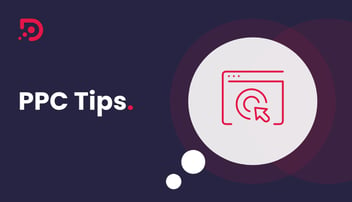If you were to rank marketing tasks in order of glamour, keyword research would be far from the top spot. But the reality is that effective keyword targeting is the backbone of a successful PPC campaign: it’s the basis on which everything else depends, and as a result, it’s important to do it right.
Or to put it another way: using the right keywords leads to increased engagement, better conversion rate, and higher ROI; winging it with your keywords leads to the opposite.
In this article, we’ll show you how to do keyword research the right way. That is the way that leads to engagement, conversions, and profit.
Here’s what we’ll cover:
- Why PPC Keyword Research Matters
- The Basics of Keyword Types
- Unearthing High-Intent Keywords
- Employing Tools for Effective Keyword Research
- Understanding Keyword Metrics
- Strategies for Expanding Keyword Lists
- Negative Keywords - Refining Campaign Performance
- Localising Your Keyword Strategy
Why PPC Keyword Research Matters
PPC keyword research matters because it lets you connect with the right audience. PPC ads are served based on the keywords in the user’s search query, and both ad copy and the subsequent conversion pathway follow from this search query.
For this reason, having a clear understanding of the terms and phrases your prospective customers are searching for determines whether or not the starting point for the whole PPC journey is the right one.
In a B2B context, PPC campaign objectives are to attract customers to your product or service. To do this you need to demonstrate that your product or service is relevant to a user’s needs and that it will address their pain points satisfactorily: an effective list of keywords will be aligned with the searches prospects are making to understand and solve these pain points.
PPC keyword research also matters for the following reasons:
- It lets you manage ad spend effectively by preventing misspending on keyword terms and phrases that hold no relevance or value for your business.
- It encourages higher conversion rates by more closely matching with user search intent and offering them a coherent conversion pathway.
The Basics of Keyword Types
To achieve the most effective keyword targeting, you need to understand the different types of keywords and their implications. In this section, we’ll look at head keywords vs. long-tail keywords, branded vs. non-branded keywords, and INCT keywords.
Head Keywords vs. Long-tail Keywords
Head keywords, also sometimes called short-tail keywords, are short keyword terms. Usually, they have a higher volume and a more generic search intent. An example of a head keyword might be “dresses”.
Long-tail keywords are those used by users to communicate a more nuanced search intent. They’re three or more words long and are associated with lower search volume and higher conversion rates. A long-tail example related to the example above might be “mother of the bride dresses” - the person searching for this clearly has a more specific need, and may be closer to making a purchase.
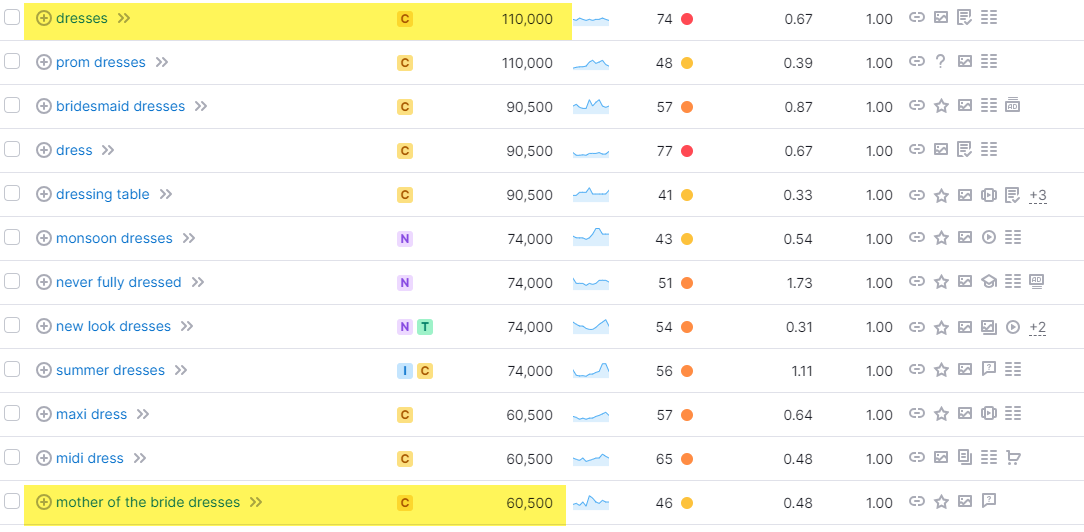
A screenshot of Semrush’s keyword info: note that the head term has 110,000 volume vs. 60,500 for the long-tail term
Each type of keyword lends itself better to certain use cases:
- Head keywords are good for building awareness, and are better suited to brands with budgets that can accommodate higher costs per click.
- Long-tail keywords are good for businesses looking to drive conversions on a smaller budget.
Branded vs. Non-branded Keywords
Branded keywords are simply those that contain the name of a brand. A user looking for “HubSpot migration services”, for example.
Non-branded keywords do not mention a brand: for example, “CMS migration”.
The distinction here is whether or not the person searching already has a brand in mind as part of their search intent. Someone searching for your brand may be more likely to engage and convert, but the converse is that redirecting search intent away from a competing brand may be very difficult.
Here are the use cases for each type:
- Branded keywords are good for customer retention, as you can increase visibility for terms mentioning your brand where you may not rank, or where competitors may try to poach traffic.
- Non-branded keywords are the most useful from a customer acquisition perspective, as the user’s search intent is more broad. They do not already have a provider in mind, and will likely go for the most relevant ad.
INCT Keywords
INCT stands for informational, navigational, commercial and transactional keywords, and each refers to a different type of overarching search intent.
Here are examples of each:
- Informational: The user needs information - “How to do PPC keyword research”
- Navigational: The user is looking for a specific page - “Google Ads Keyword Planner login”
- Commercial: The user is looking to compare options - “Best keyword research tool”
- Transactional: The user is ready to make a purchase - “Semrush sign up”
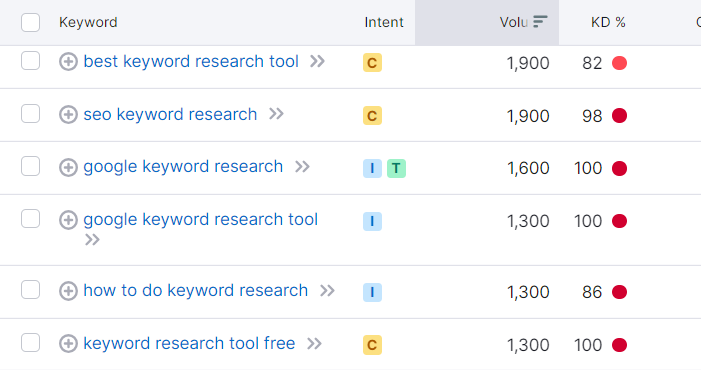
Another Semrush screenshot, this time showing which of I, N, C and T a keyword term targets
It is likely that a B2B PPC campaign will target prospective customers at various stages of their buyer journey, and running ads to target each type of INCT keyword is a way to achieve visibility at each step.
Engaging with prospects at each stage lets you provide them with the information, resources, or solutions they need, maximising the likelihood of interaction and conversion.
Unearthing High-Intent Keywords
A better understanding of the different types of keywords and what they signify in a prospective customer’s journey is helpful in identifying terms with high intent. And when we talk about intent, this is in the context of converting: whether the conversion be making a purchase or something earlier in the journey like making a comparison or signing up for a trial.
Here are some ways to identify high-intent terms:
- Look for obvious clues: terms with words like “buy,” “free trial” or demo that clearly communicate a user’s term to perform an action are likely to have higher intent.
- Look at what type of information people are looking for: if a search term asks about costs or benefits, this signifies that a user is further along the journey than top-level informational terms.
And here are some reasons why high-intent keyword terms are important:
- They signify closer proximity to conversion: a user searching for higher-intent keywords is likely to be further along the buyer journey than someone searching for lower-intent terms, meaning you can target them accordingly.
- They are likely to be more cost-effective: a higher intent means the cost per click will be higher, but the conversion rate will be as well.
Identifying high-intent terms can be time-consuming, but the potential rewards are more than worthwhile.
Employing Tools for Effective Keyword Research
Now that we've seen the importance of keyword research, the types of keywords available, and the potential benefits of finding high-intent terms, let’s look at some of the tools you can use to find PPC keywords.
You can also download our free keyword research checklist here.
Google Keyword Planner
This tool lets you search for words or phrases related to your business and will make intelligent recommendations for related terms along with giving top-level traffic data.
Because this tool is linked directly with Google’s search engine, you can be assured that the traffic data and other insights are accurate. However bear in mind that traffic is given in quite broad brackets, which can make it hard to draw definitive conclusions.
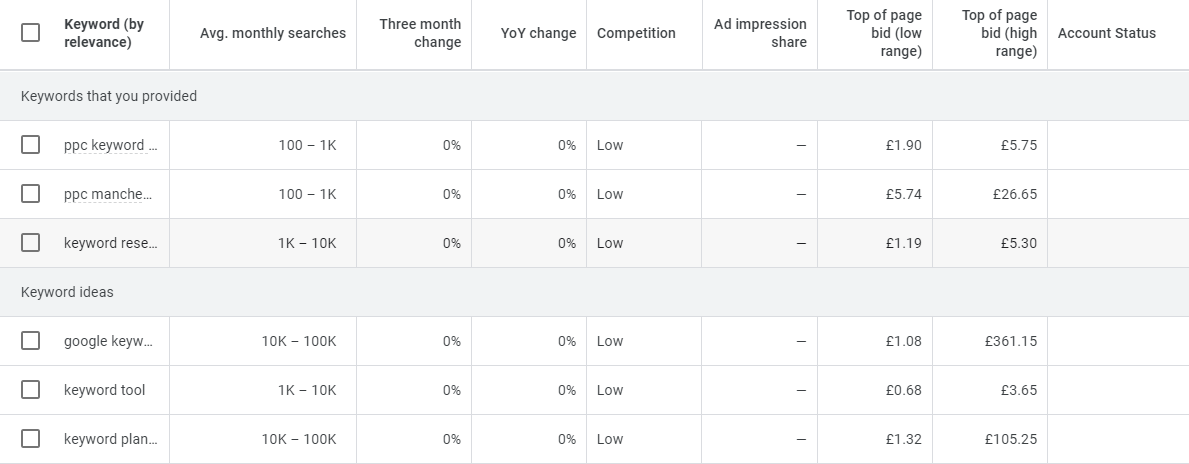
An example showing keywords related to the terms we provided along with some useful metrics
You can find the Google Keyword Planner tool here.
Pros:
- Powered by Google: accurate data
- Free to use, although you need an Ads account (also free)
Cons:
- Broad brackets given for search volume: can make it tricky to draw conclusions
- A fairly steep learning curve if you’re unfamiliar with the interface
Semrush
This is a powerful digital marketing research platform with lots of tools, but we’re most interested in the Keyword Research section.
Here you’ll find a bunch of tools to help you identify relevant, traffic-driven keywords for your PPC campaigns. You can also build keyword lists and tap into collated metrics that will give insights into your broader campaigns.

Semrush’s analysis of the same keywords above: note the more precise search volume
Check out Semrush here.
Pros:
- Tons of tools available for keywords and other areas of your campaigns
- Lots of keyword info including precise volume, trend, cost metrics, and SERP features
Cons:
- Pricey: may be a barrier for smaller businesses or those with small budgets
- Another steep learning curve
- Lots of the tools you pay for might not be very useful
Ahrefs
Ahrefs is similar conceptually to Semrush: an extensive marketing research platform with lots of tools, a selection of which are related to keywords. The capabilities are similar, and it’s a matter of personal (and budgetary) preference which you go for.
Check out Ahrefs here.
Pros:
- Lots of tools available to strengthen various aspects of your campaign
- Similar levels of keyword data to Semrush: plenty to help you find the best keywords for your campaigns
Cons:
- Pricey: As with Semrush, this may be a barrier to businesses with smaller budgets
- Can be tricky to get familiar with
- Not all tools will be relevant but you have to pay for the whole package
Answer the Public
This tool looks a little different, but the intent is the same: revealing search insights to help you refine the keywords you target. When you enter a term the site generates a report showing all sorts of searches around the term, including associated questions, prepositions, comparisons and more. The idea is to broaden the types of terms and search intent you’re taking into account when building your lists.
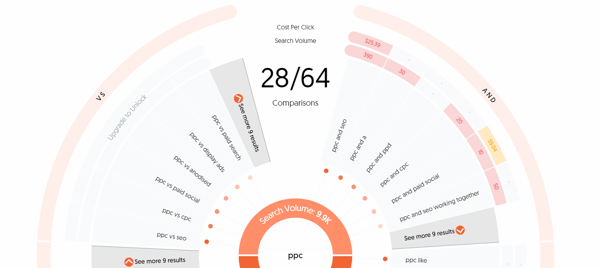
Questions related to the term PPC’ - as you can see, some are more relevant than others
Check out Answer the Public here.
Pros:
- Incredibly powerful for idea generation and broadening your keyword list
- You can run a limited amount of free reports
Cons:
- The interface is a little bit clunky
- May give inaccurate or unhelpful recommendations
- Needs to be supplemented with other tools to be fully useful
AlsoAsked
The goal of AlsoAsked is to expand your level of insight into prospective search intent around your campaign keywords. Similar to the Answer the Public, related searches are displayed visually, giving you a suite of ideas for expanding your keyword lists.
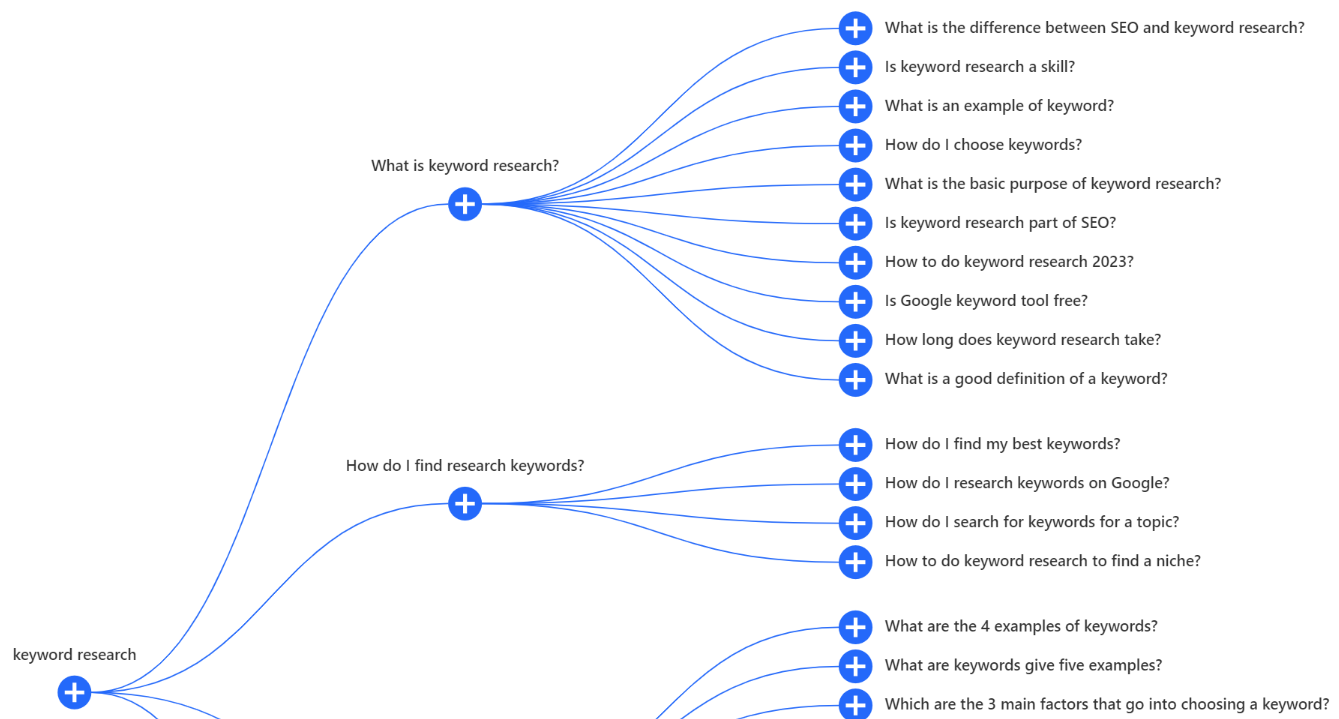
Questions related to ‘keyword research’
Check out AlsoAsked here.
Pros:
- 3 free searches per day
- You can export the results as an image: useful for brainstorming and presenting
Cons:
- No metrics attached to the keyword terms
Understanding Keyword Metrics
To get the most value from keyword research tools there are certain metrics you need to understand. Let’s take a look at some of the ones you’ll come across:
- Search volume: The average number of times a keyword term or phrase is searched for in a given time period, usually a month. Useful for gauging the relative popularity of a term.
- Difficulty: The challenge associated with ranking highly within the search engine results pages based on the competition from competitors. Useful for setting priority levels for keywords.
- CPC: The average amount you’ll pay each time someone clicks on one of your ads. Useful for gauging prospective campaign spend and for setting budgets.
- Competition: The level of competitor activity for this keyword. Useful when cross-referenced with difficulty.
- Ad Impression Share: the ratio of times your ad was shown to possible times where it could have been shown. Useful for gauging how effectively you’re capturing views.
- Top of Page Bid: the estimated maximum price for achieving the top-spot ad position. Useful for understanding potential maximum CPCs and refining budget allocations.
Strategies for Expanding Keyword Lists
With the knowledge and tools we’ve explored so far, you should have what you need to begin putting together solid keyword lists full of data-driven terms. Here are some methods for further expanding these lists to maximise their efficacy:
- Use LSI keywords: LSI stands for latent semantic indexing and refers to terms that are conceptually related to your main search terms. Search engines use LSI keywords to refine their understanding of web content, and to place ambiguous terms in context. Incorporating LSI keywords into your campaign may allow you to capture adjacent search terms with a similar intent, although we recommend researching these carefully to ensure relevance.
- Analyse your competitors: Competitor analysis provides some good insights into potential strategies. There are many ways to carry out these analyses: We recommend reading about Google Ads auction insights as a good starting point. This tool will let you view metrics like impression share, outranking share, top-of-page rate and more for yourself and your competitors.
- Google auto-suggest and related searches: When you start typing a search term into Google you’ll see recommended search terms based on what Google thinks you’re looking for. As these predictions are based on existing searches by real users, they can sometimes provide insights into related search intent. Use these with a pinch of salt, though.
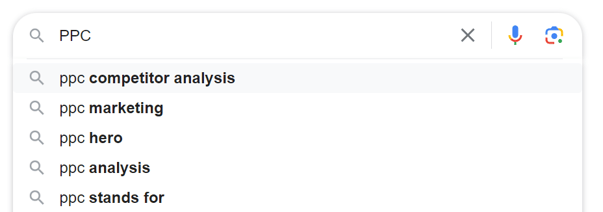
Example related search terms for ‘PPC’
Negative Keywords - Refining Campaign Performance
Sometimes the focus is on removing keywords from your lists rather than expanding them. Identifying and isolating negative keywords is a good example of this: these are keyword terms or phrases used to filter out irrelevant searches, reducing the likelihood of you paying for clicks from users with little to no interest in your brand. Utilising negative keywords effectively is linked to increased CTR, lower CPC, and better overall ROI.
Going back to the ‘dresses’ example previously. A boutique shop selling bespoke, handmade dresses may add terms like 'cheap' or 'budget' to their negative keyword lists, on the assumption that people searching for a 'cheap dress' are unlikely to have budgets that align with their product range.
If they do not sell wedding dresses, they may also use more advanced negative keywords to filter out wedding-related searches. Let’s take a look at the types of negative keywords and some examples.
The Types of Negative Keyword
There are three types of negative keywords:
- Broad match: You can set keyword phrases of 1+ words, and if all the words are in a user's search term, regardless of order, your ad won't show. A negative keyword term of “wedding dress” would prevent the ad from showing in searches for “buy a wedding dress” and “dress for a wedding”.
- Phrase match: You can set keyword phrases of 1+ words, and your ad will only not show if all the words are present in the specified order. A negative keyword term of “wedding dress” would prevent the ad from showing for “buy a wedding dress”, but it would show for “dress for a wedding”.
- Exact match: The user's search query must match exactly with your specified negative keyword. “Wedding dress” would only prevent the ad from showing for that exact query.
You can learn about how to add negative keywords to your PPC campaigns here.
Localising Your Keyword Strategy
The final thing to consider when creating keyword lists to target the right audience is keyword localisation. This is especially important for businesses operating in multiple geographical regions, as it helps to ensure that your business can be found by users in each. Localised keyword strategies improve ad relevance to each user and are associated with improved CTR and conversion rate.
Here are some simple and effective ways to leverage local variations in search when compiling keyword lists:
- Include regions: We are a PPC agency in Manchester, so we run ads for PPC-related searches that mention the city, as local businesses are likely to look for local agencies. While keyword volumes are lower, a higher search intent means our ads are more relevant to users making these searches.
- Research local terms: For businesses operating in regions with different dialects, using local terminology can ensure relevance. For example, a taxi operator with services in several cities may want to check whether or not Uber operates in each city. If they do, running ads to display alongside Uber-related terms would be worthwhile, but if not, these ads would be unlikely to serve many purposes.
- Use localisation services if running ads in different languages: Following on from the above, if you run ads in regions with different languages, simply translating keywords may not be enough. We recommend working with localisation specialists to ensure the non-English keyword phrases retain their meaning and resonance.
- Use geo-targeting: Google Ads offers location targeting tools to give you control over the countries, areas, or even specific geographic radii where your ads show. It's worth getting familiar with this powerful tool.
In Conclusion
Effective keyword targeting is the backbone of a successful PPC campaign. After reading this guide you should have the information you need to build targeted keyword lists that will perform.
Building lists with the relevant terms that people are actually searching for is the best way to achieve success in PPC campaigns. Using tools to research and refine potential keywords paves the way for greater performance, as they make it possible to find terms that are driven by data rather than guesswork.
Then, using the right metrics to track your PPC campaigns helps you to ensure ongoing performance. Collecting and analysing campaign data lets you make refinements to keyword lists and bidding strategies, gradually shifting the balance towards the terms and phrases that perform best.
Still looking for more information about PPC Services? We’ve got you covered. Find out more through one of the article below:
- B2B PPC: What is it & Why is it Important?
- PPC Management: How to Optimise Your Ad Campaigns
- PPC Strategy: A Comprehensive Guide
- PPC Ad Copy: A Comprehensive Guide
- PPC Landing Pages: A Comprehensive Guide
- PPC Tracking: A Comprehensive Guide
- PPC Analysis & Reporting: A Comprehensive Guide
- Why PPC Training Makes Sense for Marketing Managers
- How to Structure your PPC Campaign for Success
Or, why not check out our Definitive Guide to PPC Services.



